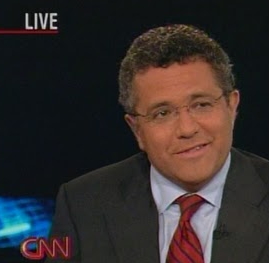Jeffrey Toobin and His Apparent Ex Both Take On The Supreme Court

Five weeks ago, Casey Greenfield published a piece in the Daily Beast about the Supreme Court, FDR and Obama, drawing from Jeff Shesol’s Supreme Power. This week, so did Jeffrey Toobin, in the New Yorker. Greenfield is the woman who is not Toobin’s wife who is raising the baby she had with him. While their approach and language differs, they come to some of the same conclusions, and even find an identical supporting quote.
Here’s her:
The public found Roosevelt’s jockeying distasteful and even indicative of dictatorial leanings. Shesol acknowledges that FDR here is seen as a “character in a Greek tragedy…blinded by arrogance after his landslide” but argues against hubris as FDR’s prime motivator: “It may have been driven… by ego and emotion, but it was also the product of reason.
Here’s him:
History’s judgment of the court-packing plot has generally been harsh, but Jeff Shesol’s new book on the subject, ‘Supreme Power,’ while acknowledging the conventional view that ego and emotion drove Roosevelt to act, notes that the plan “was also the product of reason.”
Here’s her:
After FDR’s 1936 landslide reelection, he’d had it with a Supreme Court, led by moderate Charles Evans Hughes, that repeatedly struck down his New Deal legislation. Emboldened by his victory, and frustrated by what he saw as unnecessary roadblocks to programs meant to lift the country out of the Great Depression, the president proposed extensive judicial reform legislation in February 1937. The signature component of the bill would have enabled FDR to add up to six additional Justices to the nine-member Supreme Court. FDR-who had not made a single Court appointment during his first term-could have used this expanded flexibility to “pack” the Court with Justices likely to support his legislative agenda.
And here’s him:
Emboldened by a landslide reëlection in 1936, he struck back at the “nine old men” by proposing a change in the structure of the Court: henceforth, the President would name an additional Justice for each one over the age of seventy. The justification was that the new appointees would assist their elderly colleagues with their work, but, as everyone knew, the real motive was to put enough F.D.R. appointees on the Court to allow the New Deal to proceed.
Obviously she omits the dieresis. (Tina Brown’s Daily Beast is not David Remnick’s New Yorker!)
“The parallels between Obama today and FDR in 1938 are in the zillions. The mutual enmity between Obama and Chief Justice Roberts finds precedent in FDR’s animosity toward Chief Justice Hughes” is how Greenfield made the transition to current analogy. “The forty-fourth President is now feeling the pain of the thirty-second” is the tidier version that Toobin went with.
There’s nothing really scandalous there, as you can see. It’s odd. At the very most, it shows that they may have made a good couple, what with their similar legal thinking.
Still, it’s hard to listen to Toobin go on about the law right now; he hired a lawyer to deal with his interactions with Greenfield and this lawyer, back in February, said regarding Greenfield’s paternity claim: “We do not intend to dignify plainly fabricated claims with a response.” The response in the end has actually been for him to pay her child support, so, uh, okay.
And then there’s the actually objectionable part of Toobin’s comment. It’s his odd appeal to the glorious order of Supreme Court precedent. Don’t get too frothy, you liberals, about the ability of the Court to make the country a better place!
Today, liberals applaud when the Supreme Court strikes down federal legislation restricting the rights of detainees at Guantánamo, or a state’s limitations on gay rights, and if the day comes when the Court jettisons Citizens United liberals will be too busy celebrating to remember the primacy of stare decisis. As is so often the case, in courtrooms and elsewhere, the battle between Obama and the Roberts Court is as much about power as it is about principle; neither side is as concerned with abstract concepts like activism and restraint as it is with winning.
Well, oy. Primacy? Actual lawyers will be quick to weigh in on this, and I hope they do. But it seems to me that in the late 80s, a panic consumed the then-bloggers of the New York Times about the state of stare decisis. Later, panic was shifted to the fate of what Alito famously called “super-duper precedent,” since treatment of precedent in the early age of the Rehnquist court-described (to further panic by then-Times bloggers!) by Rehnquist as “a principle of policy and not a mechanical formula of adherence to the latest decision”-had eroded, or, really, re-eroded, so far. Because what Justice Marshall called a “doctrine,” in his own panic over Rehnquist’s language, has never really been such. It was never, as liberals would sometimes have it (in otherwise good arguments), “the bedrock principle.” At least it certainly wasn’t in the Warren Court, or else we’d all be in our racially-segregated drug stores not able to buy condoms and unable to complain about such without fear of legal reprisal on our fancy blogs.
